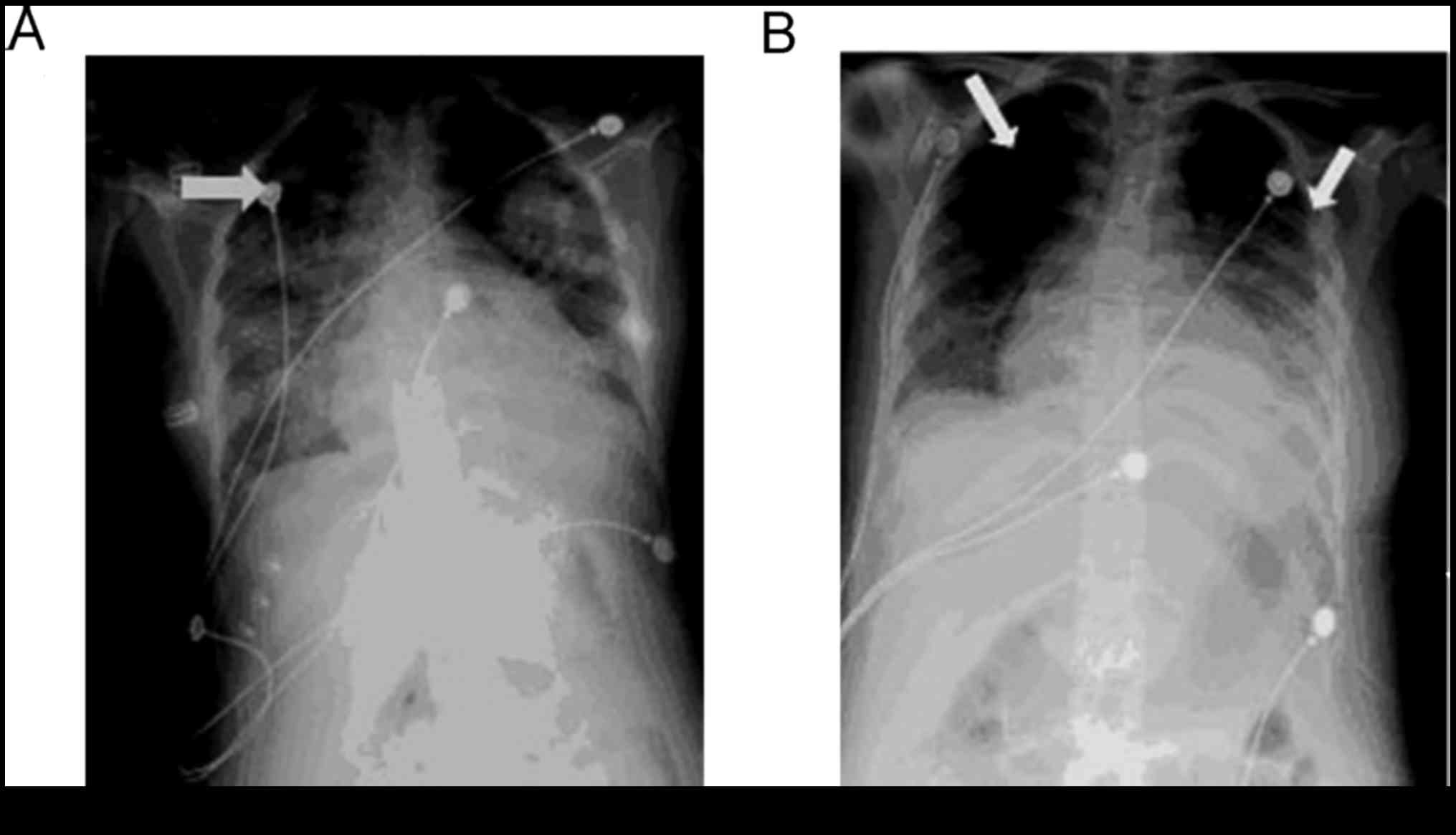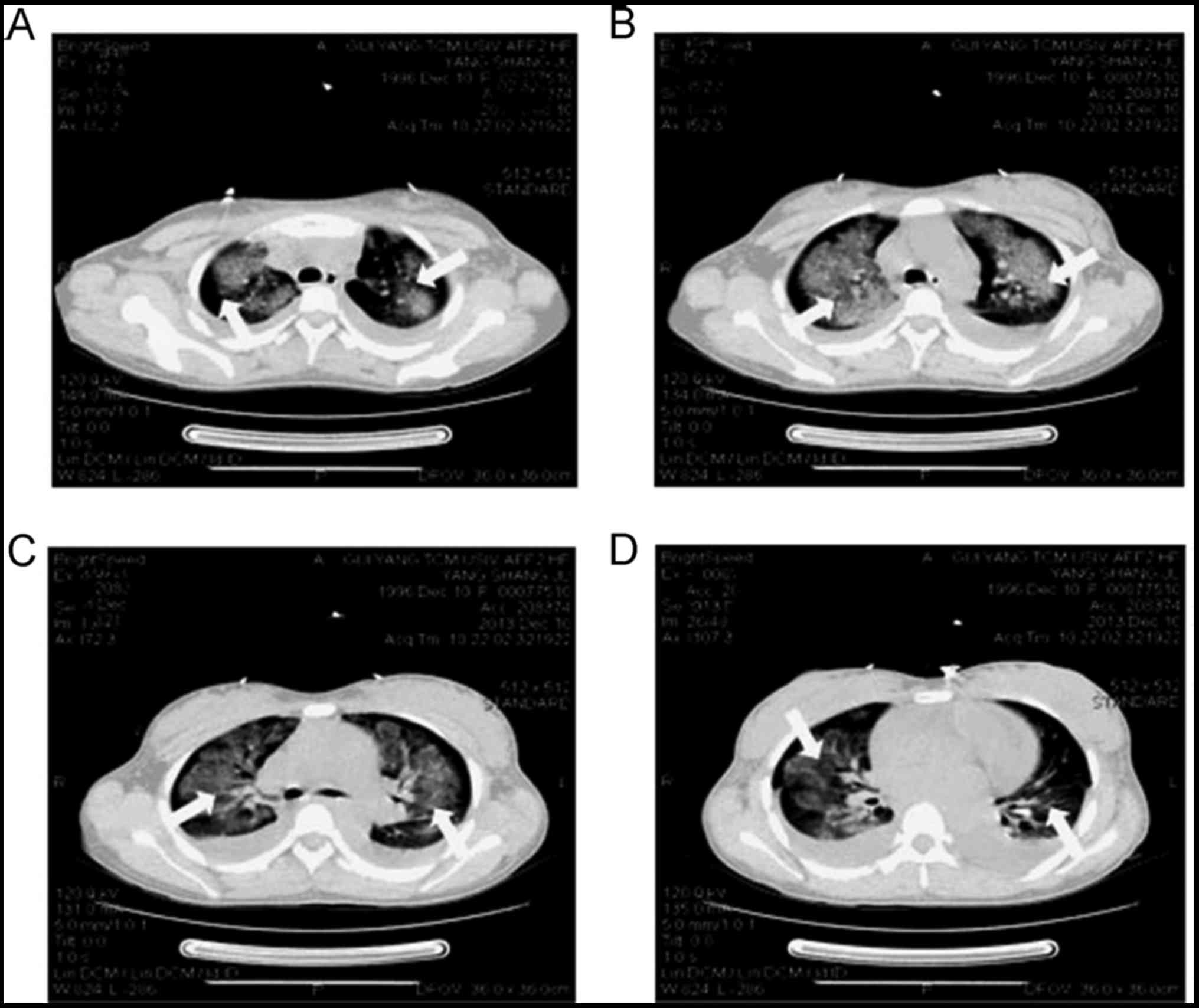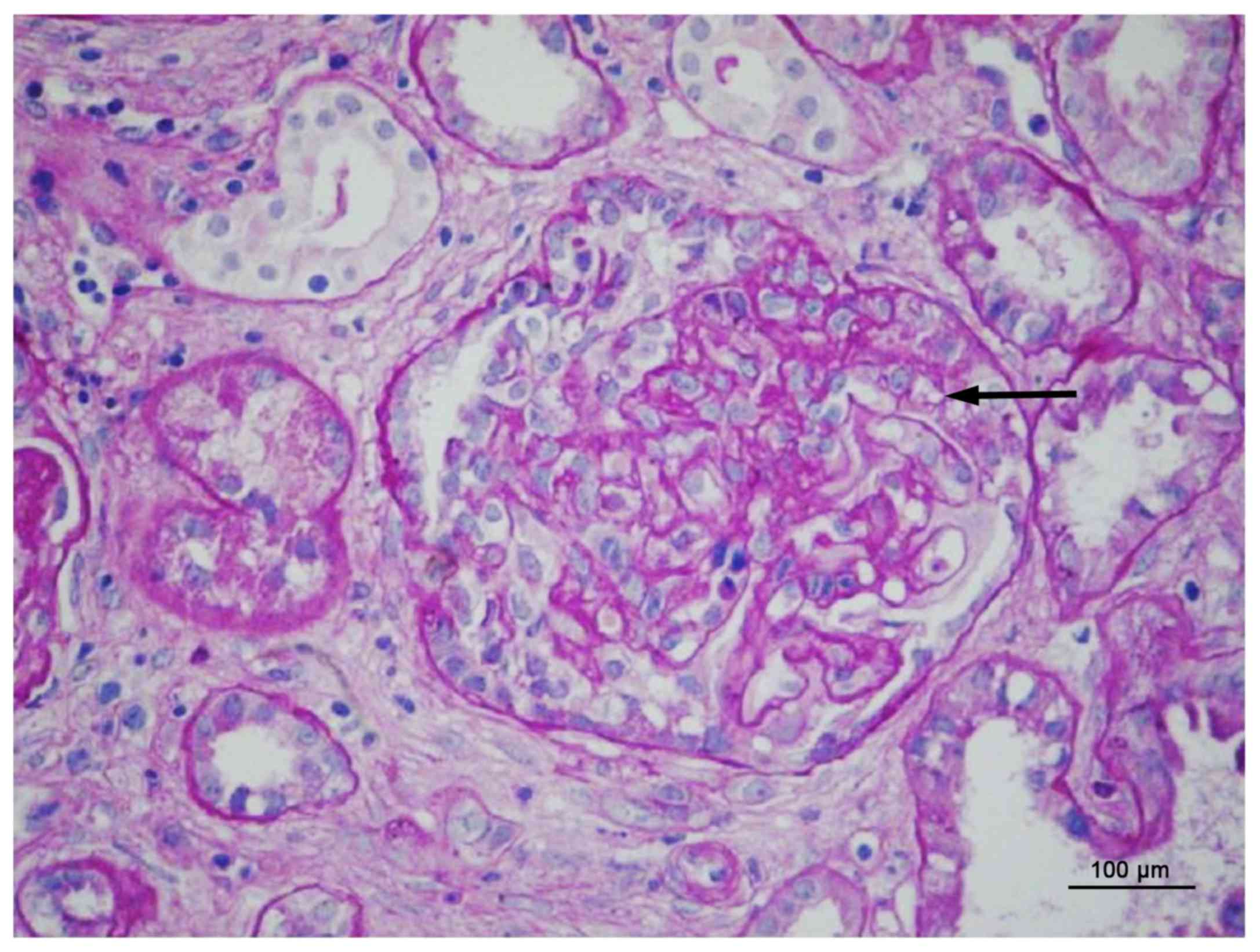Goodpasture's syndrome in early pregnancy: A case report
- Authors:
- Published online on: November 1, 2017 https://doi.org/10.3892/etm.2017.5425
- Pages: 407-411
Abstract
Introduction
Goodpasture's syndrome (GPS) is an immuno disorder characterized by pulmonary hemorrhage, glomerulonephritis and the presence of the antiglomerular basement membrane (anti-GBM) antibody (1,2). The incidence of GPS is <1 case/1,000,000 (3). Combination therapy is recommended for the initial management of the disease, including corticosteroid therapy, cytostatic therapy and plasmapheresis. However, patients have poor prognosis with current treatments and the mortality rate has been estimated as 11% (4). The etiology of Goodpasture's Syndrome remains unknown; however, the development of the disease following environmental exposures including hydrocarbon fumes, metallic dust or tobacco smoke has been reported (5). GPS occurs due to antibody and T-lymphocyte reactivity to the NC1 domain of the α3 chain of type IV collagen (6).
Women presenting with GPS in the early period of pregnancy are uncommon and the present case study reports an unusual case of GPS in the early stage of pregnancy. In the present study, the patient received hemodialysis and methylprednisolone, prior to succumbing due to sustained, irreversible renal failure. The majority of pregnancies are terminated prior to term delivery to prevent worsening of conditions (7,8). Thus, current therapeutic strategies used to treat GPS should be revised in order to improve the survival rate of pregnant patients with GPS.
Case report
A 17-year-old female was hospitalized at the Traditional Chinese Medicine Hospital of Guizhou (Guiyang, China) on 9th December 2013 due to no urination and hemoptysis for 3 days in the thirteenth week of pregnancy. The patient had history of double lower limb swelling lasting from the onset of pregnancy, which was treated with furosemide in Qianxi County Central hospital. The patient's medical history prior to pregnancy was normal; however, the patient had a 2-week history of cough prior to admission and experienced an episode of brown-colored urine 1 week later. The patient did not experience fever, dysuria or oliguria at that time. The patient visited Qianxi County Central hospital (Quianxi, China) on 21th October 2013 and was diagnosed with acute renal insufficiency. Serum was analysed using centrifugation at 37°C for 5 min at 3,000 × g. The results were as follows: Urea nitrogen, 34.98 mmol/l (normal range, 1.70–8.30 mmol/l); creatinine, 1108.0 µmol/l (normal range, 41.0–73.0 µmol/l). Urine analysis indicated that the urine was protein positive (+) and examination under a light microscope indicated white blood cell counts of 25/high power field which, indicated proteinuria and pyuria. The patient received treatment with 40–100 mg intravenous furosemide (Hunan Wuzhou Pharmaceutical Co., Ltd, Hunan, China) for four days with a total dose of 240 mg in Qianxi County Central hospital. The patient provided written, informed consent for inclusion in the present case report.
Results of examination at the time of admission were as follows: Respiratory rate, 20/min (normal range, 12–20/min); pulse rate, 116/min (normal range, 60–100/min); and blood pressure, 146/106 mmHg (normal range, 90–129/60-84 mmHg).
Laboratory findings using a Sysmex XE-2100 automatic blood cell analyzer as follows: Hemoglobin, 60 mg/dl (normal range, 115–150 mg/dl); white blood cell count, 14.3 k/mm3 (normal range, 3.5–9.5 k/mm3); platelet count, 181 k/mm3 (normal range, 125–350 k/mm3); potassium, 5.84 mmol/l (normal range, 3.5–5.3 mmol/l); cholinesterase, 2,334 U/l (normal range, 4,000–11,700 U/l); bicarbonate, 21 mEq/l (normal range, 22–29 mEq/l); blood urea nitrogen, 34.23 mmol/l and creatinine, 882.1 µmol/l (normal range, 1.70–8.30 mmol/l and 41.0–73.0 µmol/l). Serum protein levels were all normal: Myoglobin, 34 ng/ml; B-type natriuretic peptide, >5,000 pg/ml and D-dimer 1,660 ng/ml. Blood gas analysis detected a urine pH of 7.293 (normal range, 7.35–7.45), PCO2 of 24.5 mmHg (normal range, 35–45 mmHg), PO2 of 51.1 mmHg (85–100 mmHg), calcium of 0.5 mmol/l (1.1–1.3 mmol/l), Be-1 of 4.7 mmol/l (−2.7–2.7) and urine protein of 1+. All parameters were analysed using a Radiometer ABL90 micro blood gas analyzer (Radiometer Medical ApS, Copenhagen, Denmark). The levels of complements C3 and C4 were high at 195 and 57 mg/dl, respectively (normal C3 range, 90–170 mg/dl; normal C4 range 12–36 mg/dl). Antiglomerular basement membrane antibodies were positive. Anti GBM antibody was positive. Antinuclear antibody, cytoplasmic and perinuclear antineutrophil cytoplasmic antibodies (C-ANCA and P-ANCA, respectively), hepatitis panel antibody and HIV antibody tests were negative.
Chest X-ray (CXR) and computed tomography (CT) were performed with a lead coat to protect the fetus on the 3rd day (Fig. 1). CXR identified diffuse density parenchymal lesions with fibrosis in the lungs (Fig. 1A). Flake and cloud shaped lesions in the lungs identified by CT exhibited high density at different levels: The sternal angle level, aortic level, tracheal carina and bronchus (Fig. 2).
The patient was started on hemodialysis (B. Braun hemodialysis machine, Hessen, Germany) and received 1 g/day methylprednisolone (Pfizer, Inc., New York, NY, USA) intravenously for 3 days Hemodialysis parameters: Following dilution, displacement fluid, 2,000 ml/h; blood flow rate, 150–200 ml/min; temperature, 38°C; ultrafiltration, 300–500 ml/h. The patient underwent hemodialysis 6–8 h/day for five days.
A renal biopsy was taken 7 days following admission. During the hospital stay, the patient's renal function improved; urea levels were 16 mmol/l and serum creatinine was 320 µmol/l (normal range, 1.70–8.30 mmol/l and 41.0–73.0 µmol/l). Samples were centrifuged at 37°C for 5 min at 3,000 × g and parameters were measured, The patient's urine volume was within the normal range of 250–400 ml/day. However, the patient's hemoglobin dropped to 45 mg/dl and a blood transfusion was required. Following this, the patient's clinical condition improved: PO2 increased to 90 mmHg and hemoptysis disappeared 3 days following blood transfusion.
Chest X-ray (CXR) taken 10 days following admission identified a significant decrease in the diffuse density of parenchymal lesions (Fig. 1B). A CT scan was not performed at this point due to patient worries regarding fetus safety. Anti GBM antibody became negative at this point.
Renal biopsy was performed 7 days after admission. 4% Formaldehyde fixation (pH=7.0) was performed for the tissues at room temperature for 5 h. Hematoxylin and eosin staining was performed at room temperature for ~30 min on embedded tissues and sections were 1 mm thick.
It revealed cellular crescents in all 20 glomeruli observed in the biopsy specimen (Fig. 3). Light microscopic analysis of 27 glomeruli revealed 16 glomerulosclerosis. The remaining glomeruli consisted of 2 cellular crescents and 7 cell fibrous crescents with the formation of fracture and shrinkage in capillaries. The 2 glomerular mesangial cells with no crescent exhibited no evident hyperplasia and tropic complex red protein deposition. One of the two glomerular mesangial cells with no crescent exhibited ischemia and crinkle, and granular degeneration was identified in epithelial cells.
Granular degeneration was detected in the renal tubular epithelial cells and visible epithelial shedding and regeneration were detected in some renal tubular ectasia. Part of the tubular basement membrane thickened and lumen narrowing was identified. Multifocal inflammatory cell infiltration and mild fibrosis were observed in the kidney matter with thickening arteriolar walls and narrow lumens.
Once the patient was started on furosemide and methylprednisolone the pregnancy continued. However, whether these drugs administered during pregnancy increases the likelihood of the fetus surviving remains unclear.
The patient was discharged at 16 weeks gestation, 11 days following the start of treatment and ultrasound confirmed survival of the fetus at this point.
The patient attended irregular follow-up in Qianxi County hospital. Renal function declined following discharge with the results of laboratory tests indicating urea levels of 58.19 mmol/l and creatinine levels of 1,625 µmol/l (normal range, 1.70–8.30 mmol/l and 41.0–73.0 µmol/l) during the second trimester and the patient finally succumbed four weeks following discharge.
Discussion
GPS is a rare autoimmune disease with a low incidence rate of <1/1,000,000 (9). The primary clinical manifestation of GPS includes pulmonary hemorrhage, crescentic glomerulonephritis and the presence of anti-glomerular basement membrane antibodies (10). To date, there have been few case reports of GPS occurring during pregnancy (11). Therefore, it remains controversial whether the termination of pregnancy and current therapeutic strategies used to treat GPS increase the chances of full term pregnancy being achieved and improve survival rates in pregnant patients.
Few studies have described cases of GPS in women during different periods of pregnancy. To date, there have been only 4 studies investigating the effect of pregnancy on GPS. Nair et al (12) described a pregnant woman diagnosed with GPS at 13 weeks. This patient underwent termination at 15 weeks and received plasma exchange and treatment with steroids. Renal failure was resolved following treatment. Muqeet et al (13) reported that a patient with GPS experienced a rapid recovery following spontaneous abortion and speculated that the termination of pregnancy may be responsible (13). However, Deubner et al (14) postulated the hypothesis that gravidity may serve a useful role in the elimination of anti-GBM antibody titer but the relative effect of gravidity on anti-GBM antibodies remains unknown. The placenta may be an adsorptive surface for the autoantibody and may ameliorate the symptoms. The study described the case of a pregnant female with acute renal failure whom survived following delivery. The patient's accelerated decline in renal function postpartum may have been due to removal of the placenta. The patient experienced a full-term pregnancy and gave birth to a healthy infant (14). Thus, the effect of gravidity factors on anti-GBM antibody should be observed in future clinical studies, including the number of weeks at which previous pregnancies were terminated and complications of pregnancy.
The present study describes the case of a pregnant female diagnosed with GPS that experienced acute renal failure during the thirteenth week of pregnancy. The patient exhibited an improvement of renal function following regular hemodialysis and treatment with methylprednisolone. Although GPS was controlled without the patient undergoing a termination of pregnancy, there was no evidence of the effect of terminating pregnancy on the development of GPS. The results and conclusions of the present study may be difficult to extrapolate; therefore further studies are required to enable reliable analysis.
Meanwhile, assessments of the prognosis of GPS during pregnancy and delivery have attracted the attention of gynecologists. Currently, the primary therapeutic strategy used to treat GPS is plasma exchange, which may effectively remove the pathogenic antibodies in the blood and alleviate symptoms of the disease (15). Additionally, methylprednisolone serves an important role in inhibiting the formation of immune antibodies. The severity of the clinical symptoms and renal function depend on the antibody titer. Furthermore, it was demonstrated that patients with ANCA seropositivity exhibit more unfavorable prognosis (16).
The patient in the present study exhibited hemoptysis and acute renal dysfunction. C-ANCA and P-ANCA were negative and GBM was positive. Chest X-ray and CT scanning were applied to detect GPS with protective measures and the patient underwent relevant treatment. The renal function of the patient improved following regular treatment and the GBM turned negative without termination of pregnancy being performed. However, the patient did not insist on follow-up and regular treatment following transfer to a local hospital. The final clinical outcome of the present study was failure and the patient succumbed.
Factors determining the prognoses of patients include the level of C-ANCA, P-ANCA and GBM antibodies in the blood, clinical symptoms and early detection and the present study demonstrates that the length of follow-up time is important in determining patient prognosis. Even if immune antibodies turn negative, renal function should continue to be monitored, particularly during pregnancy. Levels of creatinine and urea nitrogen should be regarded as prognostic indicators and should be used to determine the treatment course.
The present study describes a case of renal failure with positive anti-GBM antibodies, which is more likely to be present in patients with progression and recurrence of renal or pulmonary disease. Previous studies investigating pregnant patients with GPS demonstrated that they may exhibit atypical presentation of antibodies in pregnancy, which may delay diagnosis and treatment (12–14). Due to its diverse clinical manifestations, gynecologists should consider the possibility of this disease when patients present with hemoptysis and renal function damage during pregnancy. Levels of anti-GBM and p-ANCA antibodies should also be checked. In the present study, a biopsy was taken to verify the disease and clinical symptoms improved following regular treatment. Winbeck et al (17) reported that early detection, early diagnosis and early treatment may improve the prognosis of patients with GPS. This was also determined in a study by Prabhakaran et al (18).
The patient in the present study exhibited clinical improvement following treatment with hemodialysis and methylprednisolone even as pregnancy progressed. However, the patient underwent irregular follow-up, which may be responsible for the decline in renal function of the patient and the endpoint of mortality. Thus, close long-term follow-up is recommended for pregnant patients with GPS.
Furthermore, pregnancy-associated complications were not monitored in the present study. Therefore, more data should be collected during the prepartum, intrapartum and postpartum periods. The incidence of fetal and maternal morbidity and mortality in women with GPS remain significant in recent years (5). Therefore, for women with GPS who want to conceive or continue with pregnancy, long-term hemodialysis should be recommended and the period of treatment determined by renal function. Appropriate contraceptive and pre-pregnancy counseling should be offered to patients with GPS of childbearing age. Improved collaboration between the obstetrics and intensive care units are also required to improve maternal survival rates and quality of life.
In conclusion, the present study reports a case of a 17-year-old primigravida who presented with Goodpasture's syndrome during week 13 of pregnancy. The patient was treated with hemodialysis and methylprednisolone as pregnancy progressed and the patient's condition improved 11 days following treatment. However, the patient discharged themselves for personal reasons and succumbed at 20 weeks gestation.
Acknowledgements
This study was supported by the Guizhou Maternal and Child Health Hospital [grant no. 2013 (2020); Guiyang, Guizhou, China].
References
|
Moulis G, Huart A, Guitard J, Fortenfant F and Chauveau D: IgA-mediated anti-glomerular basement membrane disease: An uncommon mechanism of Goodpasture's syndrome. Clin Kidney J. 5:545–548. 2012. View Article : Google Scholar : PubMed/NCBI | |
|
Wang A, Wang Y, Wang G, Zhou Z, Xun Z and Tan X: Mesangial IgA deposits indicate pathogenesis of anti-glomerular basement membrane disease. Mol Med Rep. 5:1212–1214. 2012.PubMed/NCBI | |
|
Lahmer T and Heemann U: Anti-glomerular basement membrane antibody disease: A rare autoimmune disorder affecting the kidney and the lung. Autoimmun Rev. 12:169–173. 2012. View Article : Google Scholar : PubMed/NCBI | |
|
Stojkovikj J, Zejnel S, Gerasimovska B, Gerasimovska V, Stojkovic D, Trajkovski M, Angelovska I, Debreslioska A and Jovanovski S: Goodpasture syndrome diagnosed one year and a half after the appearance of the first symptoms (case report). Open Access Maced J Med Sci. 4:683–687. 2016. View Article : Google Scholar : PubMed/NCBI | |
|
Proskey AJ, Weatherbee L, Easterling RE, Greene JA Jr and Weller JM: Goodpasture's syndrome: A report of five cases and review of the literature. Am J Med. 48:162–173. 1970. View Article : Google Scholar : PubMed/NCBI | |
|
Ramaswami A, Kandaswamy T, Rajendran T, Aung H, Jacob CK, Zinna HS and Telesinge PU: Goodpasture's syndrome with positive C-ANCA and normal renal function: A case report. J Med Case Rep. 2:2232008. View Article : Google Scholar : PubMed/NCBI | |
|
Nair S, George J, Kumar S, Gracious N and Das M: A case of Goodpasture's syndrome complicating pregnancy with dialysis requiring renal failure responding to plasmapheresis and termination of pregnancy. Ren Fail. 35:1173–1175. 2013. View Article : Google Scholar : PubMed/NCBI | |
|
Shah A, Bailey E and Hughes S: Goodpasture's syndrome, haemodialysis and pregnancy. Br J Hosp Med (Lond). 68:48–49. 2007. View Article : Google Scholar : PubMed/NCBI | |
|
Bolton WK: Goodpasture's syndrome. Kidncy Int. 50:1753–1766. 1996. View Article : Google Scholar | |
|
Salama AD, Levy JB, Lightstone L and Pusey CD: Goodpasture's disease. Lancet. 358:917–920. 2001. View Article : Google Scholar : PubMed/NCBI | |
|
Al-Harbi A, Malik GH, Al-Mohaya SA and Akhtar M: Anti-glomerularn basement membrane antibody disease presenting as acute renal failure during pregnancy. Saudi J Kidney Dis Transpl. 14:516–521. 2003.PubMed/NCBI | |
|
Nair S, George J, Kumar S, Gracious N and Das M: Acase of Goodpasture's syndrome complicating pregnancy with dialysis requiring renal failure responding to plasmapheresis and termination of pregnancy. Ren Fail. 35:1173–1175. 2013. View Article : Google Scholar : PubMed/NCBI | |
|
Adnan M Muqeet, Morton J, Hashmi S, Mujeeb S Abdul, Kem W and Cowley BJ: Anti-GBM of pregnancy: Acute renal failure resolved after spontaneous abortion, plasma exchange, hemodialysis, and steroids. Case Rep Nephrol. 2014:2437462014.PubMed/NCBI | |
|
Deubner H, Wagnild JP, Wener MH and Alpers CE: Glomerulonephritis with anti-glomerular basement membrane antibody during pregnancy: Potential role of the placenta in amelioration of disease. Am J Kidney Dis. 25:330–335. 1995. View Article : Google Scholar : PubMed/NCBI | |
|
Jara LJ, Vera-Lastra O and Calleja MC: Pulmonary-renal vasculitic disorders: Differential diagnosis and management. Curr Rheumatol Rep. 5:107–115. 2003. View Article : Google Scholar : PubMed/NCBI | |
|
Ang C, Savige J, Dawborn J, Miach P, Heale W, Clarke B and Sinclair RS: Anti-glomerular basement membrane (GBM)-antibody-mediated disease with normal renal function. Nephrol Dial Transplant. 13:935–939. 1998. View Article : Google Scholar : PubMed/NCBI | |
|
Winbeck K, Bruckmaier K, Etgen T, von Einsiedel HG, Röttinger M and Sander D: Transient ischemic attack and stroke can be differentiated by analyzing early diffusionweighted imaging signal intensity changes. Stroke. 35:1095–1099. 2004. View Article : Google Scholar : PubMed/NCBI | |
|
Prabhakaran S, Chong JY and Sacco RL: Impact of abnormal diffusion weighted imaging results on short-term outcome following transient ischemic attack. Arch Neurol. 64:1105–1109. 2007. View Article : Google Scholar : PubMed/NCBI |












